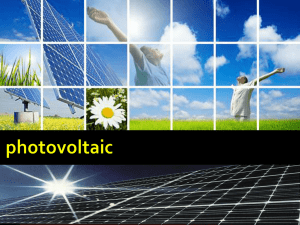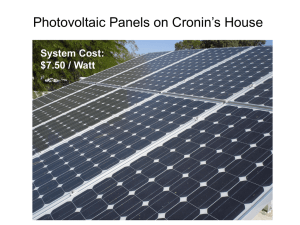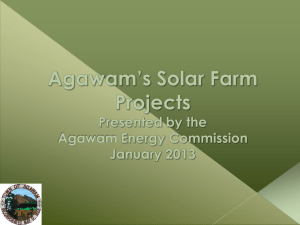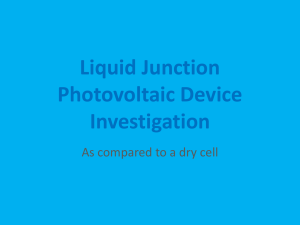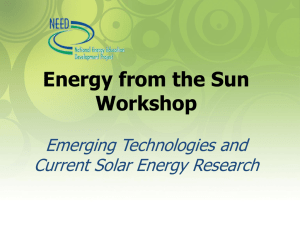Solar - UMassK12
advertisement
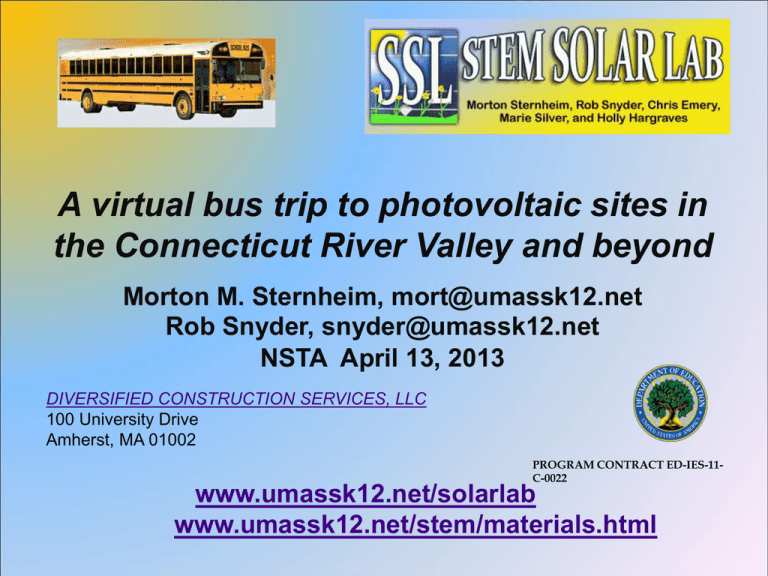
A virtual bus trip to photovoltaic sites in the Connecticut River Valley and beyond Morton M. Sternheim, mort@umassk12.net Rob Snyder, snyder@umassk12.net NSTA April 13, 2013 DIVERSIFIED CONSTRUCTION SERVICES, LLC 100 University Drive Amherst, MA 01002 PROGRAM CONTRACT ED-IES-11C-0022 www.umassk12.net/solarlab www.umassk12.net/stem/materials.html Photovoltaic solar cells Photovoltaic solar cells convert light from the sun into electrical energy “Solar Panels” or “solar arrays” of these cells have many uses On the road In campgrounds and parks In homes In schools and businesses Can you think of other places they can be used? The bus tour can start at home Many calculators have photovoltaic cells that transform light into electrical energy. The light source can be the sun or indoor lighting. You never have to buy batteries for these These are pretty common Photovoltaic driveway markers and lamps store energy during the day for night time use. Amazon.com Other off the grid rechargers For cell phones, laptops and flashlights Amazon.com On the road Photovoltaic arrays provide electricity for many road signs. Photovoltaic cells can charge batteries for night time use. A school zone blinker light on East Pleasant Street in Amherst, MA On the road Photovoltaic road signs can be portable. This is a construction warning sign at UMass Amherst. Further from home .. This is a parking permit machine in Florida Even further … Photovoltaic panels are great at locations far from the electrical grid system. Solar power runs fans and lights in a Utah rest room. Lighting Solar street lights and parking lot lights can reduce our carbon footprint. The Mullins Center at UMass Amherst Photovoltaic arrays on homes Amherst Excess electrical energy can be sold to the utility company Northampton This is a dual use photovoltaic array This array at a cohousing parking lot in Northampton, MA provides shade as well as electricity. Communities are installing photovoltaic arrays at schools Shutesbury Elementary School A 95 kW array at Smith Vocational and Agricultural HS, Northampton, MA On libraries Wendell Free Library, Wendell, MA Milne Library, Williamstown, MA Agricultural use of photovoltaic arrays Farmers can grow crops or graze cattle under arrays mounted on poles 100 kW array at the Edwards farm on route 47 in Hadley, MA UMass farm on River Road in South Deerfield, MA The Western Mass Electric Company is installing photovoltaic arrays 8200 panels produce 2.3 megawatts in Indian Orchard, Springfield, enough for 500 homes This 1.8 megawatt site at Silver Lake in Pittsfield has operated since October, 2010 The Northfield Mountain Recreation Area Array First Light has installed 18,000 panels on 11 acres that can produce up to 2 megawatts of electric power. http://www.firstlightpower.com/northfield/ Much further from home! You can’t really see them, but solar panels are a source of electrical energy for artificial satellites. The U. S. Department of Education is providing funds to install photovoltaic arrays at schools in Western Massachusetts DIVERSIFIED CONSTRUCTION SERVICES, LLC 100 University Drive Amherst, MA 01002 www.umassk12.net/solarlab PROGRAM CONTRACT ED-IES-11-C-0022 STEM Solar Labs are installed on 13 school campuses Hopkins Academy, Russell Street, Hadley MA Northfield Mount Hermon, Northfield, MA The STEM Solar Lab project Assesses site suitability, soil conditions, obtain building permits Installs support structures & panels Provides curriculum materials that can be integrated into existing courses • PowerPoint presentations, student write-ups, teacher guides are online at: www.umassk12.net/solarlab • Teacher training and materials are provided • The Enphase monitoring system provides electricity production data The SSL installation process A site with southern exposure is selected. The soil is tested to a depth of 10 feet. Heavy machinery drives long posts deep into the ground to get below the frost line. Fins provide stability. Features of SSL curriculum materials Students can • Do plant growth experiments. • Measure efficiency. • Study weather effects. • Learn how to determine which way is true south. • Locate suitable sites for a SSL. • Construct models of STEM Solar Labs. • Monitor electricity production of an SSL. Photovoltaic solar kits can be used for classroom activities. Photovoltaic cells like those in the kit in the photograph transform light into the electrical energy that can then be transformed into other forms of energy. Students learn how to use meters to study: The effect of connecting photovoltaic cells in series and in parallel The efficiency of a photovoltaic array. Maximum power output Module/array sizing The rate of energy transformation. The effect of the tilt and direction of a photovoltaic module on electricity production. The STEM Solar Lab output The SSL modules have a peak output of about 230 watts. Inverters convert the DC to AC. The SSL array has 8 modules, and a peak output of 1840 watts = 1.84 kW The average US home uses about 1 kW Typical summer output is equivalent to peak power for about six hours per day (1.84 kW)(6 h) ≈ 11 kWh A cable connects the array to the school and provides energy to replace part of the electric company supply. The Enphase web sites provide electrical power and energy production data. The Enphase web site provides graphs of electric power production. The Enphase web site also provides environmental benefits information. The carbon offset is an estimate of the number of mature trees that can absorb the CO2 that would have been produced if fossil fuels had been used to produce the same amount of electrical energy. STEM Solar Lab web site: www.umassk12.net/solarlab/
